Mind Training (Lojong) in Khyentse Wangpo’s Writings
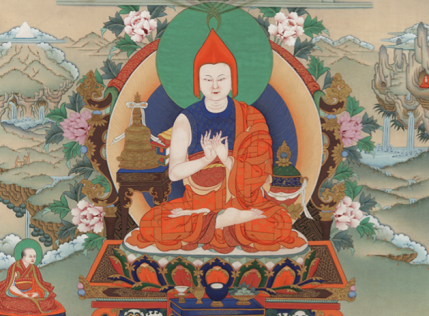
Lojong is a core practice in Tibetan Buddhism for training the mind. It involves contemplative methods for shifting our attitude and behavior toward a mindset of awakening. Since its inception in the eleventh century, mind training teachings have played an important role in all Tibetan traditions.
Jamyang Khyentse Wangpo, who embodied the nonsectarian Rimé spirit, expressed great devotion toward all lineages of the eight great chariots of practice. The Kadam tradition, from which the lojong teachings initially evolved, is one of these eight chariots. This post provides an overview of Khyentse Wangpo’s connection with the Kadam tradition, the central features of lojong teachings, and a summary of Khyentse Wangpo’s most important mind training works.
Khyentse Wangpo and the Kadam Tradition
The Kadam tradition emerged following the Bengali master Atiśa Dīpaṃkara’s (982–1054) arrival in Tibet in the eleventh century. His most prominent disciple and spiritual heir Dromtön Gyalwe Jungne (1005–1064), a previous incarnation of Khyentse Wangpo, continued to transmit Atiśa’s teachings throughout the region after his passing. The main practices of the lineage include the contemplation of the difficulty of obtaining a human life, impermanence and death, the infallibility of the law of karma, the disadvantages of saṃsāra, and the cultivation of bodhicitta. The Kadam tradition also transmitted tantric practices, most notably the “sixteen drops,” which is a deity yoga on the “four deities of Kadam”—Buddha Śākyamuni, Avalokiteśvara, Tārā, and Acala.
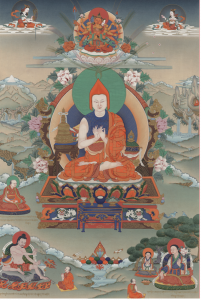
During his travels in central Tibet in his early thirties, Khyentse Wangpo had a visionary encounter with Dromtönpa at Radreng Monastery, which the latter had founded in 1056 and later became the first locus of identification for the Kadam tradition. In this vision, where he beheld Dromtönpa surrounded by his disciples seated under a juniper tree, he received a direct transmission of the Kadam teachings and their three main lineages: (1) the lineage of authoritative treatises, which focuses on the “six authoritative treatises of Kadam”; (2) the lineage of essential instructions, which focuses on Atiśa’s instructions as the basis for practice and to which the lojong teachings belong; and (3) the pith instruction lineage, comprising the secret teachings of the Book of Kadam. It was this visionary transmission—depicted in the lower right corner of the tangka to the right, with Atiśa in the center—that authorized Khyentse Wangpo as a holder of the Kadam tradition.
Inspired by this vision, Khyentse Wangpo penned an inspiring song entitled Chariot of Benefit and Happiness: A Song That Summarizes the Content of All Authoritative Treatises, Essential Instructions, and Pith Instructions of Jowo Atiśa’s Kadam Tradition, in which he skillfully summarizes the central teachings of the Kadampas and their three lineages. In the colophon of this extraordinary work, Khyentse Wangpo professes his deep admiration and devotion for this tradition. Khyentse Wangpo explains that a Kadampa, in line with the traditional etymological explanation of the term “Kadam,” is a person for whom all the teachings of the Buddha (“ka”) dawn as essential instructions (“dam”) to attain awakening.
Khyentse Wangpo’s studies of lojong were particularly influenced by Drakgön Zhabdrung Könchok Tenpa Rabgye from Amdo, one of his most important teachers and a master of the Geluk tradition. Khyentse Wangpo’s biography contains an exhaustive list of the teachings he received from Könchok Tenpa Rabgye, in total more than one hundred works. Among those are copious texts and teachings related to the Kadam tradition, which is indicative of the great respect Khyentse Wangpo held for this tradition.
The Features of Mind Training
While the origins of lojong are usually traced back to the oral teachings of Atiśa, he attributed these instructions to his own teachers, such as Serlingpa and Dharmarakṣita. These teachings were then distilled and compiled by his spiritual heirs and disciples. The key features of the mind training practices are encapsulated by the term lojong itself. The first syllable lo is a generic term for mind or thought, but in this context it also refers to our attitude toward oneself and others. The second syllable jong conveys training, cultivation, and purification.
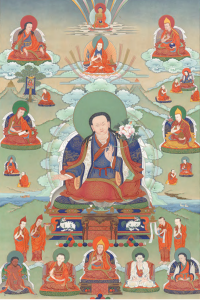
Mind training practices include the contemplation of pithy sayings that help set us on the path to awakening and liberation. They work in a practical way to change our habitual tendencies of how we relate to ourselves and others by helping us recognize our basic equality. One method to accomplish this is to consider that every being has been our caring mother through innumerable lifetimes and to understand that all beings are equal in their wish for happiness and desire to avoid suffering.
A popular practice included in lojong teachings is tonglen, literally “giving and taking,” which involves the practice of mentally giving away our happiness in exchange for the suffering of others. Through this training, the usual state of self-centeredness and egoism is transformed into altruism, or bodhicitta, in a direct and palpable way. This idea of mental transformation as the central purpose of Buddhist practice makes up the heart of the instructions of the Kadam masters.
Khyentse Wangpo’s Writings on Mind Training
In Khyentse Wangpo’s Collected Works (Kabum), there are 115 pages of writings on mind training, including some root texts authored by other masters. In Khyentse Wangpo’s own works on lojong, there is a noticeable focus on lesser-known practices that have not received much attention in the Tibetan commentarial tradition, which illustrates Khyentse Wangpo’s intention to preserve rare teachings. It is worth noting that this spirit of preservation is also reflected in Khyentse Wangpo’s reproduction or reformulation of the works of other Tibetan authors, a recurring feature of his Collected Works. Khyentse Wangpo composed five main lojong works, which are briefly introduced and summarized under the five headings below.
1. Seed of Benefit and Happiness: An Essentialized Method to Practice the Seven-Point Mind Training of the Mahāyāna
Khyentse Wangpo authored this inspiring meditation instruction based on a transmission of the Seven-Point Mind Training, a fundamental lojong work by the Kadam master Chekawa Yeshe Dorje (1101–1175), which he had received from Könchok Tenpa Rabgye. This pragmatic and approachable text reads as direct personal instructions on meditation from Khyentse Wangpo himself. The reader is guided through fundamental Buddhist subjects such as the four thoughts, the four immeasurables, refuge, and so on, and is encouraged to not only contemplate the meaning of these aspirational verses but to also put them into practice. In order to traverse the entire path in a single sitting, Khyentse Wangpo advises us to settle our minds through combining śamatha and vipaśyanā and urges us to cultivate nonreferential love and compassion for all beings by engaging in tonglen practice. Outside of the meditation session, the practitioner is advised to never separate from the essence of the main practice and always engage in virtuous activities with sustained vigilance and conscientiousness in order to “extract the essence of human existence.” The reader is further encouraged to consult sūtras and treatises about the preciousness of human life.
The text is followed by a short supplication prayer entitled Nectar of the Mind: A Supplication for the Seven-Point Mind Training, in which Khyentse Wangpo briefly summarizes the seven points in verse:
This human life, endowed with qualities so hard to find—
Bless me that I may spend it practicing Dharma day and night,
And that I may do so fiercely and with continuous diligence
Without getting distracted by the meaningless affairs of this life.
2. Necklace of Fresh Utpala Flowers: A Guide for Teaching the Mind Training: Compendium of Excellent Explanations
This teaching manual is primarily meant as a guide for a lama to instruct students as they contemplate the Compendium of Excellent Explanations over a period of seven days. Khyentse Wangpo refers to this lengthy lojong work, compiled by Zhönu Gyalchok (ca. 1382–1439), as an “instruction manual on the Seven-Point Mind Training.” The master encourages the disciples to recite different sections from the root text, guiding them through the seven points and associated aspects, such as setting the right intention for receiving the teaching and listening properly. The text includes additional elements such as the preliminary practices and a short account of the lineage in order to inspire faith.
Since there is nothing more excellent in the Dharma than bodhicitta,
exert yourselves to meditate on it!
3. Sumpa Lotsāwa’s Ear-Whispered Mind Training
The root stanza of this instruction by the twelfth-century master Sumpa Lotsāwa consists of four vajra statements, which he had received from Vajravārāhī and Tārā in a visionary encounter while circumambulating the Mahābodhi temple in Bodhgaya:
If you’re content with whatever happens, whatever you do brings happiness.
If your mind rests where it’s placed, even traveling elsewhere will be okay.
If your mind is turned to the Dharma, even dying will be easy.
If you have recognized your mind as unborn, there will be no death.
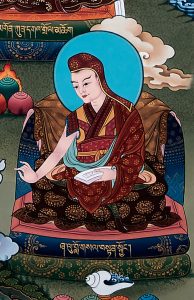
Khyentse Wangpo authored two texts related to this teaching: an instruction manual and a lineage prayer. The former, Nectar of the Heart: A Guide to Sumpa Lotsāwa’s Ear-Whispered Mind Training, is a manual for lojong practice, wherein Khyentse Wangpo elaborates on the four vajra statements and how they are to be practiced, both in formal meditation sessions and during everyday life. The Lineage Prayer to the Teachers of the Ear-Whispered Mind Training, initially penned by Ngulchu Togme Zangpo and supplemented by Khyentse Wangpo, traces a lineage that begins with the prominent master Sakya Paṇḍita (1182–1251), who had received the teaching from Sumpa Lotsāwa himself, and features other illustrious historical figures in a combined Sakya and Jonang line of transmission. It ends with Losal Tenkyong (1804–1864), one of Khyentse Wangpo’s primary teachers, from whom he received the transmission of this teaching.
4. Eight Sessions Mind Training
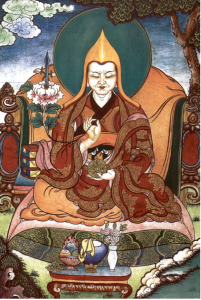
The Eight Sessions Mind Training, attributed to Dromtönpa, presents eight practical techniques to transform the mind by abandoning self-clinging and developing boundless altruistic love. Based on teachings given by Könchok Tenpa Rabgye, Khyentse Wangpo’s Succinct Notes on the Eight Sessions Mind Training offers guidance through different visualizations for the acts of eating, breathing, and making torma offerings, and even for the approaching moment of death.
Khyentse Vision Project consultant Khenpo Choying Dorjee gave a teaching on this text, which can be viewed here.
Think of your body as a wish-granting jewel
from which whatever each being desires
descends upon them like rain.
5. Mahāsiddha Virūpa’s Mind Training Instruction: The Yoga of Unparalleled Compassion
Mahāsiddha Virūpa’s Mind Training Instruction: The Yoga of Unparalleled Compassion presents a concise visualization practice of how to develop a compassionate heart, which it holds to be the very foundation of the qualities of a buddha. It is based on an eight-line quotation from a canonical text in the Tengyur by the Indian mahāsiddha Virūpa entitled A Pith Instruction on Suchness Utterly Free of Elaboration (Toh. 2020, 82b1–2):
Those who’ve protected you with boundless love are embodiments of kindness.
Think of them with compassion in this way:
“This perpetrator of harm, too, is my mother!
Though she has shown repeated kindness to me in the past,
She is out of control, as if she were insane.
Owing to her negative karma, she will suffer in the Avīci hell.”
Contemplating thus, your compassion for the three realms will become perfect.
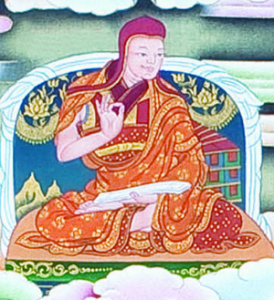
The author lays out a twofold approach—a direct meditation and a step-by-step meditation. The focus of both is to embrace even our worst enemy with compassion by acknowledging the fact that they have been our mother over many lifetimes. In the colophon to this text, Khyentse Wangpo points out that he compiled this text on the basis of an instruction manual by Jamyang Khyentse Wangchuk.
Conclusion
Based on transmissions received from the Geluk master Könchok Tenpa Rabgye, Khyentse Wangpo often drew on sources written by his former incarnation, Jamyang Khyentse Wangchuk. While he implicitly highlights practices transmitted within the Sakya tradition, as can be seen from supplementary lineage prayers and historical information offered on the lineages, the cross-sectarian nature of these works is demonstrated by the fact they had been passed on through other traditions, such as Kadam, Jonang, and Geluk.
In the five works on lojong presented above, Khyentse Wangpo gives clear and succinct advice on mind training, making the instructions accessible to a wide range of practitioners, and some of Khyentse Wangpo’s teachings on the subject include certain tantric aspects of the mind training tradition. This is particularly evident in his notes on the Eight Sessions Mind Training, where he instructs practitioners to visualize their bodies being cut into pieces and fed to harmful spirits, which alludes to the tantric Severance (Chöd) teachings of Machik Labdrön (1055–1153).
In their early phase, mind training instructions were mostly passed directly from master to disciple; later Langri Tangpa and Chekawa would make them available to a wider audience. The intimate nature of these teachings is also reflected in the fact that Khyentse Wangpo’s texts on the topic are occasionally referred to as essential instructions (damngak) or pith instructions (mengak), terms that connote a direct transmission—without necessarily including tantric content—from the master to a selected group of disciples; Sumpa Lotsāwa calls them “vajra statements.”
Mind training, which has its roots in the Kadam tradition but over time came to pervade all Tibetan traditions, has become one of the most popular and celebrated Buddhist genres, with contemporary masters frequently drawing from it in their public teachings. Because of their down-to-earth practicality, the mind training teachings constitute accessible resources for the modern-day Dharma practitioner and offer effective tools for dealing with life’s greatest challenges—whether on the meditation cushion or in daily life.
Further Reading
- Akester, Matthew, trans. The Life of Jamyang Khyentsé Wangpo. By Jamgön Kongtrul. Khyentse Foundation, 2020.
- Deroche, Marc-Henri. “’Phreng po gter ston Shes rab ’od zer (1518–1584) on the Eight Lineages of Attainment: Research on a Ris med Paradigm.” In Contemporary Visions in Tibetan Studies. Proceedings of the First International Seminar of Young Tibetologists, edited by Brandon Dotson et al., 319–42. Chicago: Serindia Publications, 2009.
- Jinpa, Thupten. Mind Training: The Great Collection. In Library of Tibetan Classics, vol. 1. Somerville, MA: Wisdom Publications, 2006.
- The Book of Kadam: The Core Texts. Library of Tibetan Classics, vol. 2. Somerville, MA: Wisdom Publications, 2008.
